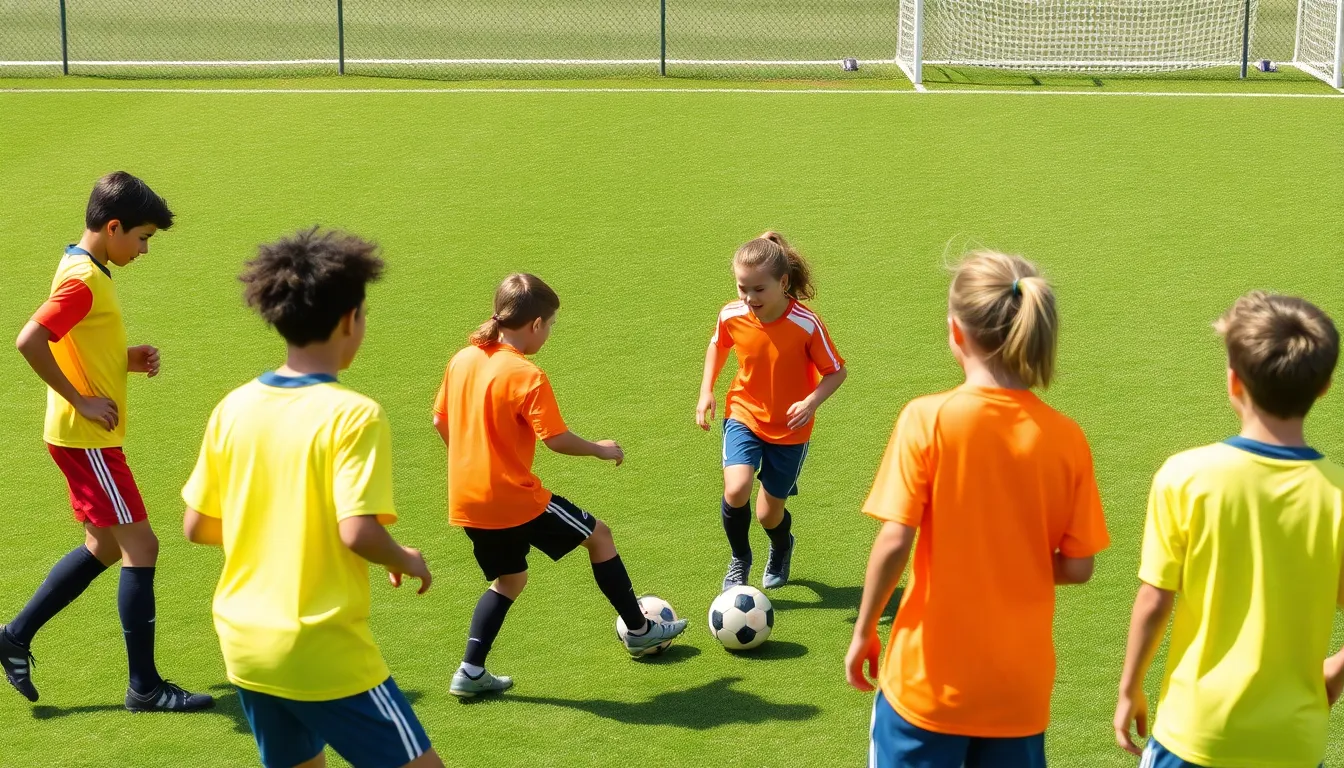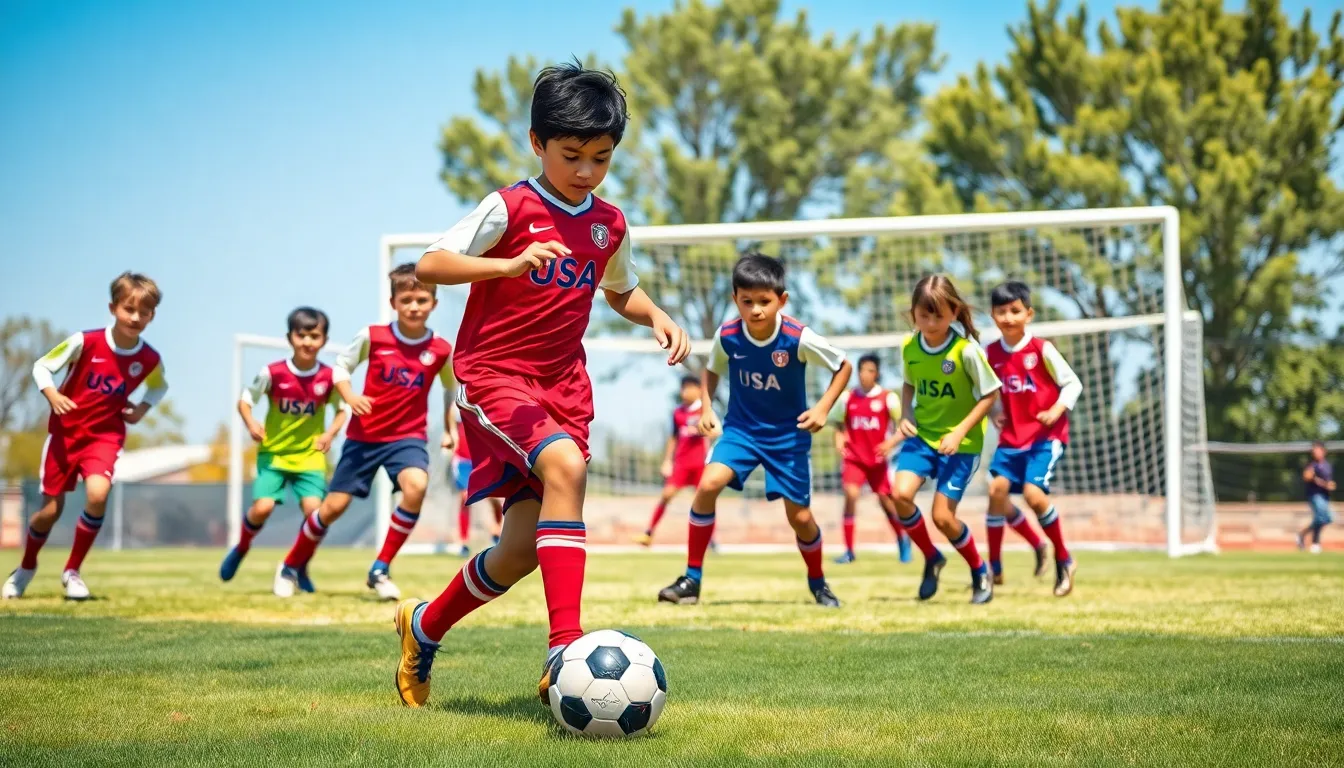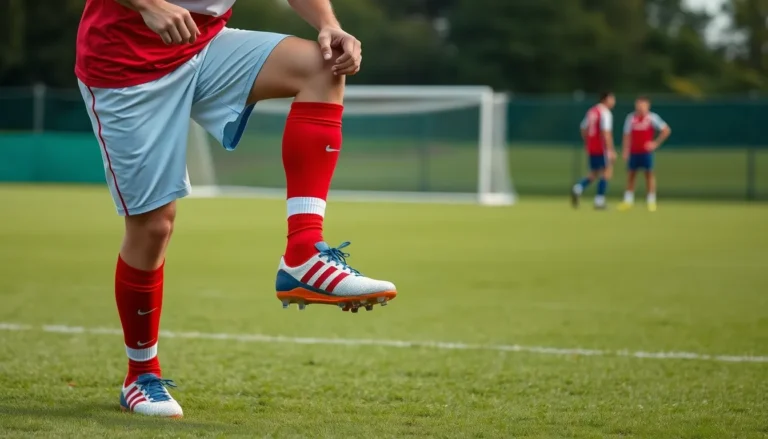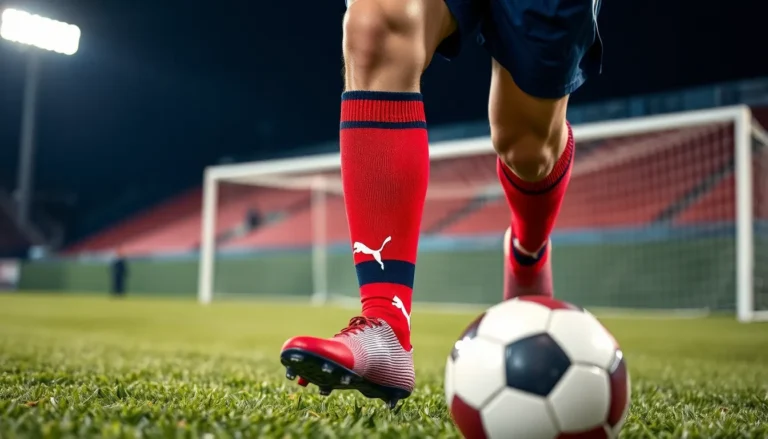In the world of soccer, possession is king. Imagine your team dancing around the field like a well-rehearsed ballet troupe, while the opposition watches in awe. Mastering possession isn’t just about keeping the ball; it’s about controlling the game and leaving your rivals scratching their heads.
Soccer Possession Drills
Soccer possession drills enhance teamwork and ball control. Drills create opportunities for players to practice passing, receiving, and movement without the pressure of competition. Specific exercises focus on maintaining possession while under defensive pressure.
Small-sided games, such as 4v4 or 5v5, emphasize quick decision-making and accurate passes. Players continuously adapt to new situations, promoting creativity on the ball. Tight spaces, like a 10×10 grid, encourage players to think quickly and find space efficiently.
Triangle passing drills teach players to maintain an effective shape while moving the ball. Players form triangles, passing in a circle to maintain possession while working on body positioning. This approach fosters communication and unity among teammates.
Pattern-based possession drills require players to execute specific movements. Players practice delivering the ball through various channels while remaining aware of their surroundings. Keeping the ball in a specific area helps develop focus and discipline.
Meanwhile, rondo drills involve a small group maintaining possession against defenders in a confined area. These drills help improve first touch, support runs, and strategic positioning. Success in rondos builds confidence in ball retentions during gameplay.
Collaboration thrives in these drills, helping teams implement possession strategies in matches. Progression into more complex drills fosters higher levels of skill and understanding. Players learn to transition between offense and defense while strengthening tactical awareness.
Importance of Soccer Possession Drills

Possession drills play a crucial role in a soccer team’s performance. They enhance skills essential for controlling the game.
Enhancing Ball Control
Ball control is fundamental in soccer. Players improve their first touch, dribbling, and passing accuracy through possession drills. Engaging in these exercises enables athletes to handle the ball under pressure. Continuous practice sharpens their ability to manipulate the ball in tight spaces. Mastering these techniques elevates confidence during matches, leading to more successful interactions with teammates and opponents. Players gain greater control, allowing them to make quick decisions on the field. Ultimately, drills that focus on ball control contribute significantly to a player’s overall effectiveness in competitive situations.
Improving Team Coordination
Team coordination thrives with proper possession drills. These drills encourage players to communicate effectively while on the move. Teams develop an understanding of each other’s playstyles and preferences. Regular practice creates a rhythm, making it easier to anticipate teammates’ actions during a game. Small-sided drills, like 4v4 games, force players to work together in tight formations. Emphasizing teamwork leads to smoother transitions during offensive and defensive plays. When coordination improves, so does the team’s ability to maintain possession, making them formidable against opposing teams.
Types of Soccer Possession Drills
Soccer possession drills come in various types, each designed to enhance players’ ability to control the ball and maintain teamwork. Understanding these drills helps in improving overall performance on the field.
Small-Sided Games
Small-sided games, including formats like 4v4 or 5v5, emphasize quick decision-making. Players constantly engage with the ball, enhancing their spatial awareness. With fewer teammates, this setup encourages creativity and skills development. Communication becomes vital in small-sided scenarios, as players must coordinate movements and passes efficiently. The limited space fosters intense competition, requiring quick adaptations to maintain possession under pressure.
Keepaway Drills
Keepaway drills focus on retaining possession while evading defenders. Players form a circle with one or two defenders inside, who try to intercept the ball. This drill hones ball control, passing accuracy, and movement off the ball. Success depends heavily on players’ ability to read the game and anticipate opponents’ actions. Practicing these scenarios builds confidence in maintaining possession in real game situations.
Rondo Drills
Rondo drills involve players forming a circle while one or more defenders work to retrieve the ball. This exercise cultivates quick passing and sharp spatial awareness among participants. As players focus on maintaining possession, they enhance their first touch and decision-making skills. Communication and teamwork thrive in this environment, leading to improved on-field cohesion. Regular practice of rondos sharpens players’ ability to retain possession under pressure, essential for match scenarios.
Tips for Effective Soccer Possession Drills
Maximizing the benefits of soccer possession drills requires focused strategies. Implementing these tips enhances player development and team cohesion.
Setting Clear Objectives
Establishing clear objectives for each drill aligns players’ efforts with specific skills. Coaches should communicate goals, whether they involve improving passing accuracy, enhancing ball control, or promoting teamwork. Identifying the desired outcomes encourages players to focus on their roles and responsibilities. For instance, during a triangle passing drill, the emphasis might be on effective communication and supporting teammates. Ensuring players understand these objectives fosters a sense of purpose, driving them to engage purposefully in practice. Defining success metrics can help track progress over time, reinforcing the importance of continual improvement.
Adjusting Drill Intensity
Adjusting the intensity of drills maintains player engagement and challenges their skills. Modifying variables such as space, number of touches, or tempo helps tailor practice to the group’s skill level. For example, increasing the number of defenders in a keepaway drill elevates difficulty while pushing players to enhance their ball control under pressure. Alternately, slowing down the game allows for focused learning, especially for younger or less experienced players. Balancing intensity ensures players remain challenged but not overwhelmed, promoting confidence and competence in their abilities. Adapting the drills based on performance keeps training relevant and effective.
Conclusion
Soccer possession drills are essential for developing a team’s ability to control the game and outmaneuver opponents. By focusing on various types of drills such as small-sided games and rondos, players can enhance their ball control and decision-making skills. These practices not only improve individual techniques but also foster teamwork and communication on the field.
Regularly incorporating possession drills into training sessions leads to a more cohesive team that can anticipate each other’s movements and execute strategies effectively. As players become more comfortable with these skills, they’ll find themselves better equipped to maintain possession during matches, ultimately leading to greater success on the field. Embracing these drills is a step toward mastering the art of possession in soccer.




